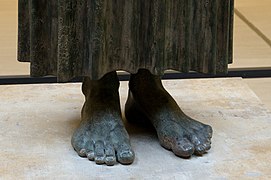The charioteer of Delphi, or Hêniokhos (in ancient Greek ἡνίοχος, "who holds the reins"), is one of the most famous sculptures of ancient Greece, and one of only five large bronzes that have come down to us from the classical period. It is preserved in the Archaeological Museum of Delphi and dated, thanks to its inscription, between two Panhellenic Games, either in 478 or 474, or between 470 and 467 BC.
Description of Charioteer of Delphi

This statue of an charioteer, a life-size chariot driver (1.82 m high), was discovered in several pieces on April 28 and May 1, 1896 at Delphi, north of the Sacred Way, between the temple of Apollo and the theater, during the excavation of the site by Homolle, Bourguet and Convert of the French School of Athens, under the direction of Théophile Homolle.
François Chamoux wrote that the statue was discovered in the rubble of the house of the "Bakal" Kounoupis, very close to the Ischégaon, where one had just demolished a terracotta water pipe.
Theophile Homolle attributes this statue to the fifth century B.C. based on its style and the name engraved on the base that supported the statue. It was destroyed during an earthquake and landslide, probably in 373 BC, which destroyed the temple of the Alcméonides.
It was preserved in three pieces, the torso and head (Inv. 3520), the right arm (Inv. 3540), and the rest of the body from the waist down (Inv. 3540). The left arm is missing. The charioteer itself was part of a larger ensemble, dislocated in the catastrophe of 373 BC, consisting of the chariot, four horses and a young servant. Fragments of the chariot, the horses' legs and tails were found near the statue.
The charioteer is depicted standing on the chariot with his feet facing forward and pointing to the left, in the same direction as his head. In his right hand he holds the reins (which are a restoration), and probably a whip, now lost. As is customary for chariot races, he wears a long chiton with folds similar to those of a column; straps tied under the armpits prevent the tunic from blowing in the wind.
His head is girded with the band of victory. The treatment of the charioteer is typical of early classicism, which preserves archaic elements, here the ovoid and austere character of the face and the flat curls of the hair. The oval of the face is full, the jaw is large, the chin is round, the lips fleshy.
The statue is designed to be seen from three quarters: the charioteer turns his head to the right, towards the spectator, the left part of the face being more developed for
Charioteer of Delphi's Technique
The statue was cast using the lost wax technique on negative in several large parts:
- the two arms ;
- the two feet ;
- the lower part of the tunic;
- the upper part of the tunic;
- the head.
The statue, generally pale yellow in color in ancient times, is composed of a complex mixture of alloys that give it a discreet polychromy. The eyes, which remain intact, are probably made of glass and stone, surrounded by eyelashes cut out of beaten sheet metal. The headband designs had tin inlays, the four teeth were probably plated with silver and the lips were made of a copper alloy, as were the tunic straps.
Strands of hair were cast separately in a different alloy from that of the head and then brought back. The same is true for the knot of the headband behind the head: its double thickness would have made it impossible to remove directly from the mold, so it was cast separately and then soldered back on, as shown by its different patina.
As for the meanders of the headband, they are damascened. In the right hand, the ring finger was made separately and soldered, a detail that remains poorly explained. It is possible that the same is true for the middle toe, since this feature is found on other sculptures, but the cut has not been identified.
The assembly technique of the arms mixes mechanical and welding techniques, as shown by the housing where the left arm was fitted. The feet were assembled by welding on the bottom of the tunic, and are divided into two: another weld was made at mid-foot.
The junction between the lower and upper parts of the tunic was hidden by a wide belt, but a restoration at this point prevents a good understanding of the assembly mechanism.
The technical perfection of this statue should be noted, both in the refinement of the color shades of the various inlays, especially on the head, and in the assemblies, which are barely visible.
Initially attributed to Pythagoras of Rhegion, it is now thought to come from an Attic workshop of severe style, perhaps that of Critios.
Function of Charioteer of Delphi
The statue was consecrated in the sanctuary of Apollo in 478 or 474 B.C. by Polyzalos, tyrant of Gela and brother of the tyrant of Syracuse Hieron I, to celebrate the victory of his racing chariot at the Pythian Games held there every four years in honor of Apollo: chariot races were an expensive event that the tyrants of Sicily were particularly fond of.
The base, made of limestone, originally bore the dedication "[Μνᾶμα Πολύζαλος με Γ]έλας ἀνέ[θ]εκε[ν] ἀ[ν]άσσ[ον]" ("Polyzalos, ruler of Gela, dedicated [this] memorial"). It was later erased, probably because it proclaimed the tyranny of Polyzalos.
It was replaced by a more neutral inscription, as a private individual would: "[Νικάσας ἵπποισι Π]ολύζαλός μ'ἀνέθηκ[εν] / ὑιος Δεινομένεος, τ]όν ἄεξ', εὐόνυμ' Ἄπολλ[ον]" ("Polyzalos, victorious with his horses, consecrated to me / the son of Deinomenos whom you, most honored Apollo, made prosper).






